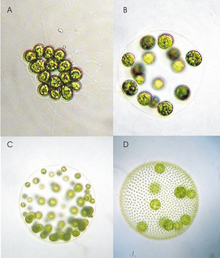| Chlamydomonadales | |
|---|---|

| |
| (A) Gonium pectorale, (B) Eudorina elegans, (C) Pleodorina californica, and (D) Volvox carteri | |
| Scientific classification | |
| Clade: | Viridiplantae |
| Division: | Chlorophyta |
| Class: | Chlorophyceae |
| Order: | Chlamydomonadales Fritsch in West & Fritsch, 1927 |
| Families | |
|
See text. | |
| Synonyms | |
| |
Chlamydomonadales, also known as Volvocales, are an order of flagellated or pseudociliated green algae, specifically of the Chlorophyceae.[1] Chlamydomonadales can form planar or spherical colonies. These vary from Gonium (four to 32 cells) up to Volvox (500 cells or more). Each cell has two flagella, and is similar in appearance to Chlamydomonas, with the flagella throughout the colony moving in coordination.[citation needed]
Both asexual and sexual reproduction occur. In the former, cells divide until they form new colonies, which are then released. In the smaller forms, typically all cells are involved, but larger forms have anterior vegetative and posterior reproductive cells. Sexual reproduction varies from isogamy (both genders produce flagellated gametes of equal size) to oogamy (one gender produces a much larger, nonmotile gamete).
The classification of the Chlamydomonadales varies. Very often they are taken to include the orders Volvocales and Dunallielales, which contain closely related unicellular flagellates, as suborders. Colony inversion is believed to have arisen twice in this order. Spheroidal colony formation differs between the two lineages: rotation of daughter protoplasts during successive cell divisions in Astrephomene, and inversion after cell divisions in the Volvocaceae.[2]

- ^ See the NCBI webpage on Chlamydomonadales. Data extracted from the "NCBI taxonomy resources". National Center for Biotechnology Information. Retrieved 2007-03-19.
- ^ a b Yamashita S, Arakaki Y, Kawai-Toyooka H, Noga A, Hirono M, Nozaki H (November 2016). "Alternative evolution of a spheroidal colony in volvocine algae: developmental analysis of embryogenesis in Astrephomene (Volvocales, Chlorophyta)". BMC Evol Biol. 16 (1): 243. PMC 5103382. PMID 27829356. Material was copied from this source, which is available under a Creative Commons Attribution 4.0 International License.